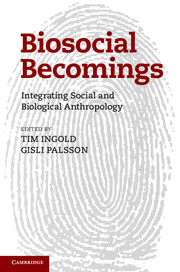Book contents
- Frontmatter
- Contents
- Preface
- 1 Prospect
- 2 Ensembles of biosocial relations
- 3 Blurring the biological and social in human becomings
- 4 Life-in-the-making: epigenesis, biocultural environments and human becomings
- 5 Thalassaemic lives as stories of becoming: mediated biologies and genetic (un)certainties
- 6 Shedding our selves: perspectivism, the bounded subject and the nature–culture divide
- 7 Reflections on a collective brain at work: one week in the working life of an NGO team in urban Morocco
- 8 The habits of water: marginality and the sacralization of non-humans in North-Eastern Ghana
- 9 ‘Bringing wood to life’: lines, flows and materials in a Swazi sawmill
- 10 Humanity and life as the perpetual maintenance of specific efforts: a reappraisal of animism
- 11 Ravelling/unravelling: being-in-the-world and falling-out-of-the-world
- 12 Retrospect
- References
- Notes on the contributors
- Index
9 - ‘Bringing wood to life’: lines, flows and materials in a Swazi sawmill
Published online by Cambridge University Press: 05 June 2014
- Frontmatter
- Contents
- Preface
- 1 Prospect
- 2 Ensembles of biosocial relations
- 3 Blurring the biological and social in human becomings
- 4 Life-in-the-making: epigenesis, biocultural environments and human becomings
- 5 Thalassaemic lives as stories of becoming: mediated biologies and genetic (un)certainties
- 6 Shedding our selves: perspectivism, the bounded subject and the nature–culture divide
- 7 Reflections on a collective brain at work: one week in the working life of an NGO team in urban Morocco
- 8 The habits of water: marginality and the sacralization of non-humans in North-Eastern Ghana
- 9 ‘Bringing wood to life’: lines, flows and materials in a Swazi sawmill
- 10 Humanity and life as the perpetual maintenance of specific efforts: a reappraisal of animism
- 11 Ravelling/unravelling: being-in-the-world and falling-out-of-the-world
- 12 Retrospect
- References
- Notes on the contributors
- Index
Summary
As the other chapters in this collection clearly show, the study of biosocial becomings calls for major epistemological shifts in the practice of anthropology. This essay is an attempt to show some of these potentialities, and focuses on the productive processes of a Swazi sawmill, engaging humans, machines, wood, and other materials, as porous overlapping organisms and things intertwined in one and the same environment. The sawmill is located in Enkopolwani, Swaziland, previously an asbestos mining town; it is now being redeveloped by the not-for-profit company Enkopolwani Ministries Swaziland (from now on EMS) as a Pentecostal Christian sustainable business project with the primary mission to provide care for orphans while producing economic wealth from activities such as timber logging and plank production.
Through detailed descriptions of life in the sawmill, the chapter also offers a systematic application of Ingold’s phenomenology of lines, flows and materials (Ingold 2006b, 2007a 2007b, 2008, 2009, 2010b, 2011) to an extended ethnographic case study, in dialectical conversation with some of the concerns of Marxist factory ethnography (Beynon 1973, Burawoy 1979, Parry 1999, Mollona 2009). It develops Ingold’s critique of agency to move beyond a view of workers, industrial machinery and intermediate and finished products interacting as separate bounded entities. Instead, it favours a perceptual engagement with life that privileges flow, flux and process, grounded in the constant production, transformation and dissolution of materials. A ‘material’ refers here to anything with intrinsic properties, enabling and constraining specific paths of becoming in the environment (Ingold 2007b: 14). Ideas are – and are made of – materials just as much as is wood or sawdust. No a priori distinction is thus assumed between mind and body, the mental and the material, the social and the biological. Materials, like their becomings, are biosocial.
- Type
- Chapter
- Information
- Biosocial BecomingsIntegrating Social and Biological Anthropology, pp. 162 - 190Publisher: Cambridge University PressPrint publication year: 2013
- 3
- Cited by

